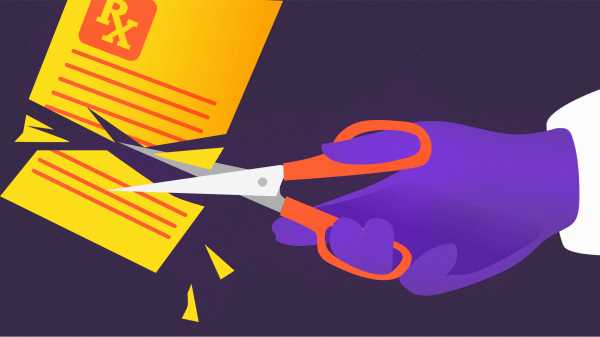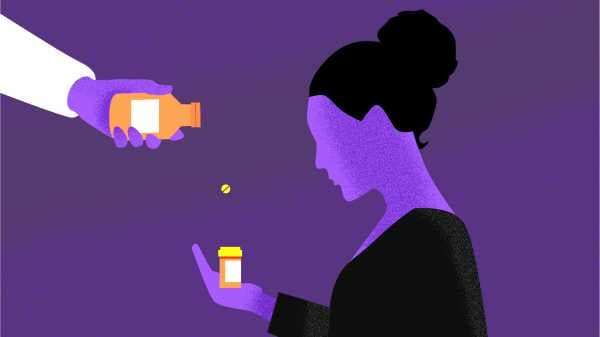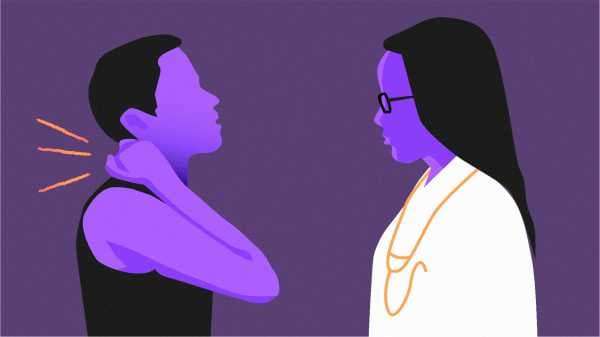
Share
Tweet
Share
Share
Solving America’s painkiller paradox
tweet
share
This year, researchers uncovered a simple method for getting doctors to reduce profligate prescriptions of drugs like OxyContin and Percocet that have contributed to America’s opioid epidemic: informing doctors that one of their patients had died.
In their study, which was published in Science in August, researchers sent a letter, through the local medical examiner, to 388 clinicians in San Diego County, California, informing them that a patient they’d prescribed a drug to had overdosed and died. The letter, which was based on actual events, came with instructions and recommendations from the Centers for Disease Control and Prevention (CDC) on proper opioid prescribing. Another 438 clinicians who had patients die were tracked but not sent letters; they were the comparison group.
The results: Clinicians who got the letters prescribed nearly 10 percent fewer opioids than those who did not receive a letter. The letter-receiving clinicians were also less likely to start patients on opioids and less likely to give patients higher doses of opioids.
For researchers, it was a promising outcome — the discovery of a nudge that could help abate an opioid epidemic that has become the deadliest drug overdose crisis in US history.
“It’s one piece of the puzzle; it’s not the end-all solution,” Jason Doctor (yes, Dr. Doctor), the lead researcher on the study, told me. “I think we’re going to need a lot of these nudges to bring prescribing down.”
The nudge stands in contrast to the more heavy-handed policy efforts that lawmakers around the country have embraced lately to limit doctors’ opioid prescribing abilities. Congress is currently considering setting caps on how long doctors can prescribe opioids for, and several states have already passed such limits. Some states have gone even further; Oregon has considered a Medicaid policy that would force chronic pain patients off opioids.
These policies intend to take on a serious problem: A record 72,000 people died of drug overdoses in 2017, at least two-thirds of which were linked to opioids, according to recent CDC estimates. While most opioid deaths are now linked to illicit opioids like heroin and fentanyl, the roots of the epidemic lie in the easy prescribing of opioid painkillers — which led not just to misuse by patients, but also misuse by recreational users who could buy or otherwise obtain a new supply of excess pills from friends, family, and the black market. Many, perhaps even most, opioid users in addiction treatment started on painkillers.
But Jason Doctor, as well as other experts I spoke to in reporting this story, told me that while they support pulling back America’s overall levels of opioid prescribing, these strict legal limits are the wrong approach. Keith Humphreys, a drug policy expert at Stanford University, said he suspects that legal limits on opioid prescribing “will cause a lot of suffering” among pain patients who won’t be able to get drugs that they genuinely need.
This is America’s painkiller paradox. On one hand, nearly 15,000 overdose deaths in 2017 were tied to opioid painkillers, and many more are linked to an addiction that began with painkillers.
On the other hand, there are as many as 100 million adults in the US who have a chronic (long-term) pain condition (anything from mild persistent back pain to disabling full-body pain), according to the Institute of Medicine. And there are many patients with acute (short-term) pain, caused by injuries, surgeries, or diseases. Many of these patients, although not all or even most, may genuinely need opioids to mitigate pain.
As former Surgeon General Vivek Murthy put it, “Twenty years ago, the medical community acknowledged that we were not adequately treating pain, but the pendulum swung too far in the direction of prescribing opioids. As we confront this epidemic, we don’t want the pendulum to swing too far in the other direction.”
So I reached out to experts with a question: How do you fix opioid overprescribing without leaving behind pain patients?
Part of the solution, experts told me, are nudges like that in the Science study, instead of mandates and caps like those state governments have enacted. It’s also important to make non-opioid pain treatment available to patients, while training health care providers in the right way to wean patients off opioids.
These solutions, though, need to come together to strike a balance — because there is no one silver bullet to solving this problem. Here’s what America will need to do.

1) Reduce opioid prescriptions — with caution
America prescribes far more opioids than any other country in the world. Based on global statistics and comparisons, that’s not because the US has so many more people in pain; it’s because US doctors are simply more likely to prescribe opioids, and insurers are more likely to pay for the drugs.
This reflects, in part, a shift in recent decades toward more and more opioid prescribing. While CDC data shows US opioid prescribing is down since 2010, the amount of opioids prescribed per person in 2015 was more than triple what it was in 1999. At the same time, studies have found that Americans’ reported levels of pain have not decreased.
In fact, the research increasingly suggests that opioids are far from a panacea for pain in general and are likely a bad idea in the majority of cases for chronic pain — in large part because people develop a tolerance to opioid effects so quickly that the pain relief over time wears off, even as the risks of overdose and addiction remain or increase.
On the chronic pain front, Erin Krebs at the University of Minnesota conducted the best study on this topic to date, releasing the findings earlier this year. Her findings: Patients on opioids did not have superior pain outcomes compared to those who avoided opioids.
She told me, “This was really the first long-term trial of opioid therapy. This is not a trial of one drug versus another. This is a trial of one prescribing strategy versus another — avoid opioids versus go for opioids.” It was not only a randomized controlled trial (the gold standard in research), but it also lasted a year, far and above past studies that had by and large run for eight to 12 weeks.
For acute pain caused by, say, a bone fracture or surgery, opioids are generally more effective. After all, concerns about tolerance and addiction are mitigated when the patient is only briefly using the drugs.
But even with acute pain, there’s been overprescribing. A 2017 review of the research published in JAMA found that across different kinds of procedures, 42 to 71 percent of opioid tablets obtained by surgical patients go unused. That’s a lot of extra pills that can be misused, stolen, or sold on the black market.
A common example: A dentist gives a patient 30 days of opioids after wisdom tooth removal — even though opioids may not be necessary beyond, maybe, three days or even at all. Patients could then misuse the excess pills or give or sell the drugs to others who would misuse them. In these cases, cutting back opioid prescriptions would be harmless, since these patients are getting too many of the drugs anyway.
In response, lawmakers across the country have imposed caps on the number of days — typically three or seven — that opioids can be prescribed to acute pain patients, as well as other restrictions for chronic pain prescribing. The limits, however, have not only deterred overprescribing but also, according to several reports, led some doctors to drop patients who may genuinely need opioids.
“There is a problem if you don’t give doctors flexibility, because there are exceptions,” Jane Ballantyne, president of Physicians for Responsible Opioid Prescribing (PROP), told me. “But at the same time, if you don’t have rules that reflect what should be done in most cases, then it’s very hard for there to be any control at all in prescribing.”
Andrew Kolodny, an opioid policy expert at Brandeis University, said he likes that the laws imposing hard limits “are focusing on an important issue — overprescribing of opioids for acute pain.” But while a limit of three days might be enough for the vast majority of people suffering from acute pain, he said that “there are people for whom three days is not going to be enough.” At the same time, if the limit is too long — say, seven days or more — that might end up being too much for most patients, so overprescribing would continue.
Kolodny, who’s also a member of PROP, instead suggested requiring a signed informed consent form for every first-time prescription that’s written for more than three days. The patient would have to sign a form acknowledging that the doctor informed him or her about the risk of opioids. This helps educate the patient, Kolodny said, but also adds “extra work” to the prescription — without making it impossible or too burdensome.
“The main reason patients get more than three days is because the doctor doesn’t want to be bothered with a phone call” when patients need to renew their prescription, he argued. “It’s more convenient.” Requiring an extra hurdle, he said, “would create a new default.”
Stefan Kertesz, a researcher at the University of Alabama Birmingham who has advocated against strict limits, had another idea: forcing prescribers to manually approve renewals of opioid prescriptions at more regular intervals through a low-barrier electronic system. “It’s an off-the-cuff idea,” Kertesz told me. “But to the extent that you’re prioritizing reductions and you don’t want to mess up care patterns, it’s plausible.”
Humphreys, of Stanford, pointed to another idea: A recent study in JAMA found that simply lowering the default number for opioids prescribed in an electronic medical record system significantly cut the number of pills prescribed, even though the system still let prescribers manually increase or decrease the number of pills that were doled out.
Experts had many other proposals, from sending letters about patients overdosing to new education efforts to screening tools to mandatory addiction training for opioid prescribers. The ideas focused on nudging, rather than mandating, prescribers to do the right thing.
“The idea is not to constrain clinical decision making,” Kolodny said, “but to make it a little harder for doctors to casually overprescribe.”

2) Don’t abruptly cut off patients who are on opioids
Even if the goal is fewer opioid prescriptions, experts said it’s important that doctors don’t abruptly cut off all patients who are on opioids. That could lead some to suffer unnecessary pain or withdrawal or, perhaps worse, push patients toward dangerous illicit drugs — even if they’re not technically addicted to opioids.
In explaining the risks here, Anna Lembke, an addiction doctor at Stanford and author of Drug Dealer, MD, emphasized the difference between addiction and dependence.
Just about everyone who uses opioids for months or years will form dependence, meaning that their bodies and brains will become accustomed to the drugs. So if they’re suddenly pulled off opioids, they will suffer withdrawal, which at its worst is often described as similar to a mix of the worst flu and very high levels of anxiety. Withdrawal can get so bad that many people will do anything to avoid it, including using illicit opioids like heroin and fentanyl — which, based on a recent study, could lead to more deaths because the illegal opioids are often more potent and volatile than opioid painkillers.
Addiction, meanwhile, is when someone compulsively uses a drug despite negative consequences. So someone can be dependent on opioids but otherwise function just fine in their day-to-day life, leading a normal life with a good job, family, relationships, and so on — meaning that they’re not addicted. In fact, only a minority of people who ever use opioids become addicted. (Some research conservatively estimates that about 8 percent of opioid painkiller patients become addicted.)
Patients who are dependent but not addicted “don’t actually meet the diagnostic criteria for addiction,” Lembke told me. “They may be on extremely high doses and be very dependent, but perhaps it was all prescribed by a single well-intentioned physician.”
For the people who are addicted, the solution is straightforward: get them into addiction treatment. Addiction treatment remains inaccessible in much of the US, but some states, including Vermont and Virginia, have worked to change that — particularly by boosting access to proven opioid addiction medications like methadone and buprenorphine.
For patients who aren’t addicted, though, addiction treatment wouldn’t do anything. These patients may be dependent on opioids (and therefore suffer withdrawal), but their drug use was not leading to compulsive use and obvious negative outcomes throughout their lives. Even if they turn to heroin or fentanyl, that may be, from their perspective, a means to treat their pain, not out of a desire to get high.
That doesn’t mean that simply keeping these patients on high doses of opioids is a good idea. That may be necessary for some patients; Kolodny of Brandeis said that “there are a lot of people who you should, really, just leave them alone if they’re on modest doses.” But in other cases, a consistently high dose of opioids can create big risks — of future addiction, future overdose, or other opioid-linked problems, from increased risk of bone fracture to constipation. And, as noted by the research above, the opioids may not even lead to better outcomes than other treatments for pain.
In the high-dose situations, health care providers can taper their patients off opioids entirely or to a lower dose — a process in which a dose is reduced over an extended period of time.
Tapering, though, can get extremely technical. It involves carefully observing doses and looking for any warning signs or harms that pop up along the way. It also may involve other kinds of services, such as emotional support to address the anxiety that patients can feel if they’re worried that losing opioids will bring back their pain or comprehensive chronic pain treatments that help address the pain that opioids couldn’t.
“We have to educate doctors about how to taper patients off of opioids,” Lembke said. “In medical school, we get a lot of education about how to start patients … but we don’t really get any training on how to take patients off.”
There’s another wrinkle: What if a patient doesn’t want to get off opioids even if the drug is doing them harm? In these cases, doctors may need to force a taper — which creates its own problems.
“A forced taper may be something you need to begin or attempt when you see harm that is either equal to or in excess of the benefits of your treatment,” Kertesz, of Alabama, told me.
He gave the example of a patient he saw in the late 1990s who was on opioids, including methadone for addiction treatment, and benzodiazepines, an anti-anxiety drug that is particularly dangerous in combination with opioids. There were other concerns, including massive weight gain from fluid retention and sudden sleeping. “We were forced by the situation,” he said, acknowledging that the patient was unhappy with the taper. “Sometimes helping people means not necessarily pleasing them.”
The risk with a forced taper is that patients could abandon a doctor who does really know best — perhaps pushing them to the streets to get opioids. Doctors and other providers have to know how to navigate these “difficult conversations,” Lembke said, without getting patients so upset that they leave. And a forced taper should be done as a last resort, not as the norm.
The good news, Lembke said, is she’s seen many patients do much better at the end of the process. She pointed to patients who actually reported less pain after they were tapered off opioids, perhaps because they no longer experienced painful withdrawal, or perhaps due to diminished opioid-caused hyperalgesia (when opioid use heightens sensitivity to pain).

3) Treat pain without opioids
Limiting the amount of opioids in circulation, though, will in many cases be only the first step. There’s still a large population in the US with untreated chronic pain. Without real help for them, doctors and patients may feel a need to resort to opioids once again — and so the opioid crisis would continue.
This is the “fundamental problem” with efforts to cut back opioid prescriptions that don’t make alternative pain treatments more accessible, said Beth Darnall, a pain psychologist at Stanford: “We can’t just go in and impose limits without providing a sufficient infrastructure of alternatives.”
“If we’re taking opioids away, we have to give people something else — information, education, support, non-opioids, it might be pharmacological strategies, it might be movement-based therapies,” she added. “But the imperative is to treat pain better, not just to limit opioids.”
There are all sorts of evidence-based, non-opioid interventions for pain. As a few examples, there are self-management strategies, movement-based physical therapy, psychological treatments such as cognitive behavioral therapy, acupuncture, chiropractic, and more than 200 non-opioid medications (yes, including marijuana).
Krebs of the University of Minnesota argued that non-medication treatments have an even stronger evidence base because there’s longer-lasting research for them than for opioids. “We need more research,” she said, “but I think there’s promising evidence of effectiveness for a lot of non-drug trials.”
But the other approaches, just like opioids, won’t work for everyone equally. Pain is highly individualized, tied to factors ranging from the extent of an injury (if one exists) to mental health to a person’s living environment. So to some extent, getting the right treatment to a patient will involve trial and error as well as good clinical judgment — a process that asks for expertise and access that just doesn’t exist in all parts of the country.
“There are many barriers,” Darnall said, from insurance not paying for non-opioid treatments to a lack of pain treatment providers.
A key problem here is that doctors receive very little training on pain — only about 11 hours on average in US medical schools (out of thousands of hours of total training), according to a 2011 study published in The Journal of Pain.
Given that pain problems are so widespread, Darnall said that doctors need to be much better trained in this field, and more private and public resources could be dedicated to pain specialists and clinics.
Some of this may also require serious systemic reform in the health care system. Lembke has long argued that it’s the structure of the health care system — and the “pressure on [doctors] to see a large quota of patients in a single day” — that helped cause the opioid epidemic in the first place. In this setting, taking a few seconds to write a prescription was simply much easier than the research, conversation, and referrals that may be needed for a doctor to link patients to alternative pain treatments. (As doctors often quip about opioids, “It takes 30 seconds to say yes and 30 minutes to say no.”)
For patients, it’s also much easier to pop a pill than to take time off work or away from their families to participate in physical therapy sessions spanning hours and weekly acupuncture or chiropractor appointments. Figuring out how to deal with those barriers, too, is a part of the problem.
“There’s a lot of hidden costs there,” Beth Hogans, a pain expert at Johns Hopkins School of Medicine, told me. “We’re not currently assigning the right costs to the various treatment options.”
The idea is not to stop the use of opioids for chronic pain entirely. But there needs to be room for safer alternatives first, with opioids remaining as a fallback option if all else fails and if they can be shown to work better than the alternatives (which, again, is very often not the case for chronic pain).
More broadly, some experts I talked to spoke of having to rethink, as a society and culture, how pain is viewed. “Something needs to be worked through the culture as well about how pain is part of life,” Humphreys of Stanford said. “If you’re in excruciating pain, it sucks. And I’ve had pain conditions myself. But not all pain is intolerable or needs to be pushed down to zero with an opioid.”
This is already a part of comprehensive pain care in some clinics, where patients can be taught techniques to, for example, live with their pain, mitigate pain by changing daily routines, and not catastrophize pain (which on its own can lead to more pain as the brain gets stuck in a vicious cycle). The idea is to confront the reality that not everyone can lead pain-free lives.
That’s absolutely not to say that people should be forced to deal with grueling, disabling pain. But learning how to self-manage may be the only option in some cases.
4) Look at pain more comprehensively
Outside of treating pain directly, experts also pointed to what some described as the “root causes” of certain kinds of pain. The idea is that the causes of pain can be fairly messy — sometimes pain is caused not by an injury, but by seemingly invisible psychological or other issues.
Brian Resnick explained for Vox:
It’s not that this pain isn’t real. It is very real — people truly feel it, and it can be absolutely disabling. But if the problem is really psychological, then more traditional pain treatments like physical therapy may not do much, if anything. The right treatment may not be even directly related to the pain.
Consider: A 2017 study published in the Journal of the American Board of Family Medicine found that 51 percent of recipients of opioid prescriptions suffer from depression, anxiety, and other mental health conditions.
There’s a valid question, Hogans said, over whether some of the people getting these prescriptions are in fact treating the symptom — “psychic wounds” that arise from, say, depression — rather than the root cause, meaning the depression itself. In such instances, the opioids aren’t just ineffective but potentially expose the patient to additional risks in addiction and overdose.
Acknowledging these root causes may make the health care system’s job of treating pain even more difficult, since it requires considering all sorts of factors — particularly mental health issues and the potential causes of mental health problems, like a lack of purpose in life, joblessness, homelessness, and much more.
“It is really complicated, but as health care providers it’s our job to assess risk, mitigate risk, and do things that are as safe as possible,” Hogans said.
This is pertinent to both treating pain and preventing addiction, which is often linked to other mental health issues, as well as overdoses.
Kertesz, pointing to data on overdose deaths, has argued that mental health issues are actually a much better predictor of overdose risk than whether a patient is on a high dose of opioids. “Taking a stable person at 200 milligrams [of opioids] down to 140 matters far less — far less — than taking a person who’s currently on 30 milligrams with unmanaged PTSD and getting him to treatment for PTSD,” he said.
Once again, access to better health care is a hurdle. Insurers have, historically, resisted paying for mental health care. A 2017 study by Milliman, a health care consulting company, found that in 2015, insurers on average paid more than 21 percent more for primary care services than behavioral services, and that behavioral care was as much as 5.8 times more likely to be provided out of network than physical or surgical care.
Even when patients do get to the right doctor, there are, again, financial disincentives to taking time to work through complicated issues. “The health system itself does tend to punish and discourage taking time to listen and evaluate problems where the intervention will be one of primarily learning from the patient, educating them, and counseling,” Kertesz said. “Those are not highly reimbursed activities.”
There are also patient barriers, from stigma toward mental health care to having to take time off work or other obligations to regularly go to therapy sessions.
All of this creates an uneven environment for pain and mental health care. So for people who can’t access a clinic that offers comprehensive services, and for the doctors seeing such patients, a pill seems like a relatively easy answer. And that’s the problem.
Sourse: vox.com





